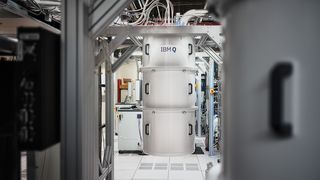Quantum technology represents a major opportunity for Australian research and strategic interests. Continuing collaboration with trusted partners – especially the US – is necessary to share in investments, build strategic capability, and realise the benefits of quantum.
Last month, Australia took another step towards realising its quantum potential and signed a joint statement with the US to advance collaboration on quantum science and technology cooperation “through improved market access and knowledge sharing.” Quantum technology will therefore be elevated in existing alliance engagements, with a priority focus on joint research, design, and standard setting and protection of sensitive research.
Both countries recognise the potential economic, social, and security implications of quantum technology across industries from defence and finance to pharmaceuticals and agriculture. Although projections vary greatly, a conservative CSIRO estimate suggests the global quantum market could be worth at least $86 billion by 2040, which does not even capture the value created by productivity gains, job creation, and indirect industry growth. The Boston Consulting Group puts the overall figure between $450 billion and $850 billion in the next 15 to 30 years.
Last month, Australia took another step towards realising its quantum potential and signed a joint statement with the US to advance collaboration on quantum science and technology cooperation “through improved market access and knowledge sharing.”
The joint statement comes off the back of growing political momentum to deepen high-tech cooperation in response to power shifts in the Indo‑Pacific region – not least, China’s economic, military, and technological rise, including successes in areas like quantum communications. Most notably, the trilateral Australia-UK-US security partnership “AUKUS” announced in September will foster integration of security and defence-related science, technology, and industrial bases. The goal is to support Australia’s acquisition of nuclear‑powered submarines and critical technology collaboration, including on quantum, which could include projects like position, navigation, and timing solutions in GPS-degraded or denied environments.
These developments bode well for Australia. Of all the critical and emerging technologies, Australia has strong foundations to be a maker and shaper of the coming quantum revolution and gain a share of the payoffs. After all, at least three decades of investment by academia, industry, and government has resulted in high concentrations of world-class talent and innovative companies like Silicon Quantum Computing and Q-CTRL.
But to become a quantum leader, Australia needs to rapidly amplify and accelerate its national approach, especially amid a changing global context. While Australia was an early leader in quantum research globally, over the past decade, other countries and companies have ramped up their investments much faster than Australia. A report by the Australian Strategic Policy Institute in May noted public quantum investments had reached over $13 billion in China, $3.15 billion in Germany, $2.86 billion in France, $2.6 billion in the US, $1.3 billion in Japan, compared with investments of around $350 million in Australia.
The time for Australia to scale up its efforts has arrived. At the inaugural Sydney Dialogue in November, Prime Minister Scott Morrison announced a Blueprint for Critical Technologies which sets out the steps being taken to promote and protect critical technologies. Quantum is a top priority on a list of 63 technologies considered consequential for the national interest. The government will also develop a National Quantum Strategy to cement Australia’s leadership role, building on existing plans and drawing on expertise from a National Committee on Quantum, led by Australia’s chief scientist, Dr Cathy Foley. In the meantime, the government will allocate $111 million over the decade to help translate research into products and services, including $70 million for a Quantum Commercialisation Hub.
These strong, internationally connected networks and their associated access to talent, technology, and knowledge have been a cornerstone of Australia’s success – and broader global progress – in the field.
As policy leaders focus their attention on strategy planning, the first question that needs to be asked is what does the best possible quantum‑enabled future for Australia look like? While there are a range of possibilities, one may be that by 2030, Australia has a thriving, sustainable quantum ecosystem, is recognised globally as a hub for research, talent, and quantum businesses, and is a leading exporter of commercial and defence-related quantum technology to trusted partners, in some applications. This would also support Australia to understand and mitigate potential risks associated with more advanced quantum technology, such as how to protect legacy encryption. To achieve such as vision, underlying plans will need to set out ambitious, practical, and sustainably funded short and long-term actions.
All levels of government have crucial roles to play in a reinvigorated national approach to the quantum ecosystem. Infrastructure investment, such as New South Wales’ innovation and technology precinct, Tech Central, which includes a Quantum Terminal, can promote collaboration. Removing barriers, such as adjusting immigration settings to enhance access to talent as mobility increases as the country reopens to the world, provides a unique opportunity to grow the workforce pipeline. Providing insight into specific requirements, especially defence and national security challenges, helps signal opportunities for sovereign industry and shapes research projects to best meet end‑user needs. Tax incentives and direct funding can accelerate research programs, and new structures such as a technology development office could support innovation and commercialisation. All these initiatives also help attract multinational firms, who make their own investments in the ecosystem.
Deepening existing collaboration will be key to success at every step, not only between governments, academia, and industry, but especially with international partners. Practically every quantum research initiative is comprised of multinational teams of experts. These strong, internationally connected networks and their associated access to talent, technology, and knowledge have been a cornerstone of Australia’s success – and broader global progress – in the field. And that will continue to be the case, notwithstanding that there will always be areas of commercial competition among partners.
In a more challenging security environment, there is also a clear need to have appropriate safeguards in place to protect sensitive research from unwanted knowledge transfer, theft of intellectual property, and industrial espionage. Australia will need to continue to carefully weigh up trade‑offs for the national interest associated with enhanced due diligence measures and more restrictive approaches to research collaboration. Working with partners Australia can trust will be important for defence and national security-related quantum initiatives. In this regard, the Australia-US joint statement adds another important string to the bow of existing channels for sensitive scientific cooperation, including AUKUS and Five Eyes fora, and developing arrangements under the Quad grouping of Australia, the US, Japan, and India.
For now, momentum is growing in government, industry, and academia to capitalise and build on decades of work. The challenge ahead is to ensure that a national strategy is underpinned by strong ambitions matched by necessary funding, engaging all levels of government, and fostering all parts of Australia’s quantum ecosystem. Continuing collaboration with our most trusted partners – especially the US, bilaterally and through AUKUS – will be necessary to share in investments, build strategic capability advantage, and realise Australia’s quantum potential long-term for the benefit of all Australians.






